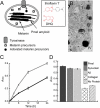Functional amyloid formation within mammalian tissue
- PMID: 16300414
- PMCID: PMC1288039
- DOI: 10.1371/journal.pbio.0040006
Functional amyloid formation within mammalian tissue
Abstract
Amyloid is a generally insoluble, fibrous cross-beta sheet protein aggregate. The process of amyloidogenesis is associated with a variety of neurodegenerative diseases including Alzheimer, Parkinson, and Huntington disease. We report the discovery of an unprecedented functional mammalian amyloid structure generated by the protein Pmel17. This discovery demonstrates that amyloid is a fundamental nonpathological protein fold utilized by organisms from bacteria to humans. We have found that Pmel17 amyloid templates and accelerates the covalent polymerization of reactive small molecules into melanin-a critically important biopolymer that protects against a broad range of cytotoxic insults including UV and oxidative damage. Pmel17 amyloid also appears to play a role in mitigating the toxicity associated with melanin formation by sequestering and minimizing diffusion of highly reactive, toxic melanin precursors out of the melanosome. Intracellular Pmel17 amyloidogenesis is carefully orchestrated by the secretory pathway, utilizing membrane sequestration and proteolytic steps to protect the cell from amyloid and amyloidogenic intermediates that can be toxic. While functional and pathological amyloid share similar structural features, critical differences in packaging and kinetics of assembly enable the usage of Pmel17 amyloid for normal function. The discovery of native Pmel17 amyloid in mammals provides key insight into the molecular basis of both melanin formation and amyloid pathology, and demonstrates that native amyloid (amyloidin) may be an ancient, evolutionarily conserved protein quaternary structure underpinning diverse pathways contributing to normal cell and tissue physiology.
Figures





References
-
- Petkova AT, Leapman RD, Guo Z, Yau WM, Mattson MP, et al. Self-propagating, molecular-level polymorphism in Alzheimer's beta-amyloid fibrils. Science. 2005;307:262–265. - PubMed
-
- Chen S, Berthelier V, Hamilton JB, O'Nuallain B, Wetzel R. Amyloid-like features of polyglutamine aggregates and their assembly kinetics. Biochemistry. 2002;41:7391–7399. - PubMed
-
- Sekijima Y, Wiseman RL, Matteson J, Hammarstrom P, Miller SR, et al. The biological and chemical basis for tissue-selective amyloid disease. Cell. 2005;121:73–85. - PubMed
-
- Tanaka M, Chien P, Yonekura K, Weissman JS. Mechanism of cross-species prion transmission: An infectious conformation compatible with two highly divergent yeast prion proteins. Cell. 2005;121:49–62. - PubMed
-
- Dobson CM. Protein chemistry: In the footsteps of alchemists. Science. 2004;304:1259–1262. 1261. - PubMed
Publication types
MeSH terms
Substances
Grants and funding
LinkOut - more resources
Full Text Sources
Other Literature Sources

